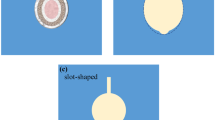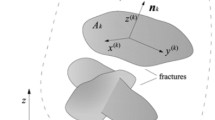Abstract
In this paper, an inverse mapping is used to transform the previously-derived analytical solutions from a local elliptical coordinate system into a conventional Cartesian coordinate system. This enables a complete set of exact analytical solutions to be derived rigorously for the pore-fluid velocity, stream function, and excess pore-fluid pressure around and within buried inclined elliptic inclusions in pore-fluid-saturated porous rocks. To maximize the application range of the derived analytical solutions, the focal distance of an ellipse is used to represent the size of the ellipse, while the length ratio of the long axis to the short one is used to represent the geometrical shape of the ellipse. Since the present analytical solutions are expressed in a conventional Cartesian coordinate system, it is convenient to investigate, both qualitatively and quantitatively, the distribution patterns of the pore-fluid flow and excess pressure around and within many different families of buried inclined elliptic inclusions. The major advantage in using the present analytical solution is that they can be conveniently computed in a global Cartesian coordinate system, which is widely used in many scientific and engineering computations. As an application example, the present analytical solutions have been used to investigate how the dip angle of an inclined elliptic inclusion affects the distribution patterns of the pore-fluid flow and excess pore-fluid pressure when the permeability ratio of the elliptic inclusion is of finite but nonzero values.
Similar content being viewed by others
References
Lamb H (1975) Hydrodynamics. Cambridge University Press, London. 738 p
Phillips OM (1991) Flow and reactions in permeable rocks. Cambridge University Press, Cambridge. 279 p
Obdam ANM, Veling EJM (1987) Elliptical inhomogeneities in groundwater flow—An analytical description. J Hydrol 95:87–96
Stratton JA (1941) Electromagnetic theory. McGraw-Hill, New York. 615 p
Wallstrom TC, Christie MA, Durlofsky LJ, Sharp DH (2002) Effective flux boundary conditions for upscaling porous media equations. Transp Porous Media 46:139–153
Zhao C, Hobbs BE, Ord A, Peng S, Liu L, Mühlhaus HB (2006a) Analytical solutions for pore-fluid flow focusing within inclined elliptic inclusions in pore-fluid-saturated porous rocks: Solutions derived in an elliptical coordinate system. Math Geol 38:987–1010
Zhao C, Hobbs BE, Ord A, Hornby P, Peng S, Liu L (2006b) Theoretical and numerical analyses of pore-fluid flow patterns around and within inclined large cracks and faults. Geophys J Int 166:970–988
Zimmerman RW (1996) Effective conductivity of a two-dimensional medium containing elliptical inhomogeneities. Proc R Soc Lond A 452:1713–1727
Author information
Authors and Affiliations
Corresponding author
Rights and permissions
About this article
Cite this article
Zhao, C., Hobbs, B.E., Ord, A. et al. Inversely-Mapped Analytical Solutions for Flow Patterns around and within Inclined Elliptic Inclusions in Fluid-Saturated Rocks. Math Geosci 40, 179–197 (2008). https://doi.org/10.1007/s11004-007-9138-0
Received:
Accepted:
Published:
Issue Date:
DOI: https://doi.org/10.1007/s11004-007-9138-0




